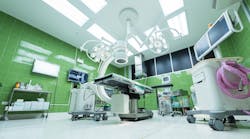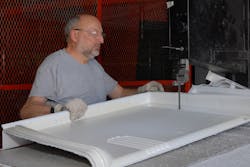This article was originally published on MedicalDesign.com in April 2014.
Although technology is the star in medical devices from MRI and blood analysis machines to CT and PET scan equipment, none could function without the custom covers, panels, housings, enclosures, and other parts that provide sensitive electronic components needed for structure, protection, and aesthetics.
Custom medical device parts have long been made from thick-gauge thermoformed plastics for cost-effective quality and cosmetics. Recent advances in thermoforming technique and technology have increased the advantages.
As a manufacturing process, thick-gauge thermoforming traditionally involves heating a 1/16-in to 5/8-in plastic sheet to a pliable forming temperature, shaping it in a mold, and then finishing it into a usable part. The result is an extremely durable, anti-abrasion, lightweight, thermoplastic part with crisp features and fine surface detail.
With recent advances, however, medical device designers and manufacturers now have a range of new options, starting with a thick-gauge thermoforming capability of some vendors to create parts up to 9 feet by 13 feet, big enough for even the largest MRI covers.
A worker at Kintz Plastics makes oversized thick-gauge thermoformed parts, which are lighter and stronger at half the cost of fiberglass parts.
Beyond this are new choices ranging from built-in, anti-microbial agents, to a twin-sheet thermoforming process that simultaneously thermoforms two sheets of plastic and bonds them together. Additional options include screen printing, hot stamping of logos, and even assembly, fabrication, and fulfillment.
Oversized Medical Parts
MRI, PET, CT, and other medical equipment designed to image an entire human body, or significant parts of it, can be massive. Even x-ray, radiology, mammography, incubator, and diagnostic blood analysis equipment can be rather bulky.
For larger parts, the traditional approach has been to use molded fiberglass. However, fiberglass has size, wall thickness, and radii limitations and is typically quite heavy. This is not the case for oversized thick-gauge thermoformed parts, which are lighter and stronger at half the cost.
Yet, creating parts large enough to encompass the entire human body is unique to all but a few thermoformers because it requires a large capital investment that only a few can make. For MRI applications, a thermoforming machine must be capable of forming parts up to 9 feet by 13 feet with a 60-in draw. These machines are so large that one has been nicknamed “Jumbo,” the largest four-station rotary thermoforming machine available in the eastern United States.
Built-In Anti-Microbial Protection
In health care, it is particularly important to maintain a hygienic environment to restrict the spread of disease or contaminants. But that can be difficult in a clinical setting, with a variety of patients and personnel using medical devices, even with routine equipment cleaning.
One helpful new option for medical device manufacturers is to add an anti-microbial agent during the manufacturing process that fights microbes such as bacteria, fungi, mold, and mildew for the life of the product.
When the anti-microbial agent is spread throughout the thermoformed material, its protection is effective both on its surface and in its substrate, and will not wash or wear off.
Twin-Sheet Thermoforming
An advanced vacuum-forming technology called twin-sheet thermoforming is ideal for all medical device parts that will be seen from both sides, need added strength, or that will house insulation, mechanical or electronic components. The process simultaneously thermoforms two sheets of plastic, then bonds them together to create a double-walled structure that is durable, lightweight, and economical.
Since twin-sheet thermoforming replaces two processes with one, it saves time and labor, creates a seamless part and stronger structure, and results in a lighter, more cost-effective component.
On a recent redesign of enclosures for a medical diagnostic testing instrument, twin-sheet thermoforming reduced the cost of the doors by 30 to 50 percent, compared to a fiber-reinforced plastics (FRP) process. Compared to injection molding or blow molding, twin-sheet thermoforming can reduce tooling costs by up to 90 percent and cut tooling development time in half, by some estimates.
Early Vendor Assistance
Because every thick-gauge thermoforming application is unique to each medical device, some vendors are willing to send engineering teams to the customer during the early stages of development to provide consultation.
Even the largest, most sophisticated biomedical companies can benefit from early vendor involvement. Such was the case for Beckman Coulter, a company that develops, manufactures, and markets biomedical testing products.
The company’s diagnostics division in Chaska, Minn., realized significant improvements in the manufacture of several blood analysis instrument parts after partnering with its plastics vendor.
The Kintz Plastics manufacturing facility in Howes Cave, N.Y., produces thermoformed plastics for the medical device industry.
“Engineers know the required design outputs, but the product can benefit from expert vendor input,” said Sean Peters, Beckman senior procurement analyst. “When Kintz Plastics helped our engineers with thick-gauge thermoforming material selection and manufacturability on several blood analysis instrument parts, we achieved at least 20% cost savings, 20% time savings, and enhanced quality with a three-month ROI on the tooling. Any time we can reduce the cost of material, it goes right to our bottom line.”
When a thermoforming design and engineering team consults with medical device designers or manufacturers, some of the factors considered include: necessary part rigidity versus flexibility, appearance, cost, finish options, text or graphics, conductivity, compatibility, as well as density and weight.
For example, to enhance the appearance of six covers in an acclaimed “vein viewer” (a device that makes veins visible to the naked eye via projection of a real-time image of the underlying veins onto the patient’s skin), the plastics vendor recommended a design with a formed-in undercut. This enabled the covers to fit so precisely together on the unit that all the seam lines are uniform once assembled.
Partnering for the Long Term
From design engineering to fulfilling and shipping the thick-gauge thermoformed part, the more a vendor has to outsource any aspect of the work, the greater the potential for delays in product delivery. For the best results and turnaround, manufacturers should work with a plastics vendor with in-house engineering, tooling, and post-forming capabilities.
A thermoformer with its own engineering staff can provide practical, on-site expertise to the design and engineering process. Such a a one-stop shop that makes its own tooling, trim, route, paint, screen print, assemble-and-ship products has more direct control over the entire process and can complete the job faster and at lower cost.



